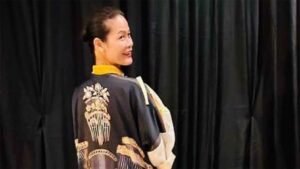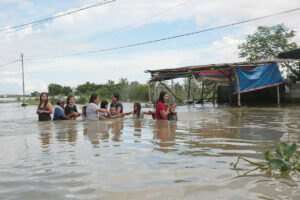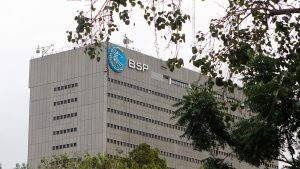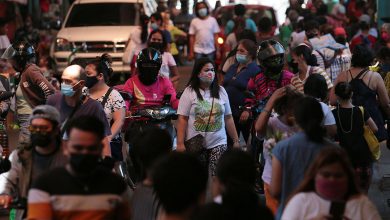Jo Ann Bitagcol: From factory worker to model to photographer to designer

MANY of our things are fated to outlive us, and it is with these objects that our stories will be pieced together and told.
In the case of 1990s Filipina supermodel Jo Ann Bitagcol, artifacts are helping her make a new story for herself. While she has already transitioned from model to a photographer, Ms. Bitagcol begins another path by venturing into fashion design.
In a launch on June 15, Ms. Bitagcol showed off her second collection of clothing at Rhett Eala’s Greenbelt store. Her first collection, Baul (the Filipino word for a storage trunk or chest), was made of photographs of antique clothing given life anew as prints on silk. The photographs came from a hoard Ms. Bitagcol accumulated as outtakes for Fashionable Filipinas, a book by designers and creative industry personalities Gino Gonzales and Mark Lewis Higgins. Those were made about four years ago. Ms. Bitagcol veers into antique jewels for this new collection, called Tao (the Filipino word for a person).
“Every season, I have to come up with some prints, right? I always go to Gino Gonzales for reference. ‘What else do you have that I can share to the world?’ He collects a lot of things, right?,” Ms. Bitagcol told BusinessWorld in an interview. Mr. Gonzales and Ms. Bitagcol arranged the accessories into the shape of people, made into characters that reflect the senior women in a Filipino family: Lola (grandmother), Tita (aunt), Ate (older sister). She also took inspiration from the late artist Mauro “Malang” Santos (himself the patriarch of an artistic family). “When I go to galleries and all that, I’m always drawn to his work. I like the colors — here, it doesn’t show color — I like the composition,” she said.
Ms. Bitagcol can print anything and patch them on clothes and call it a day, but it’s important for her to showcase Filipino items. “Since I started with culture, honoring our roots and heritage, I might as well go consistent(ly) about it. This idea of putting culture into my photographs gave me a sense of direction — personal also. Parang nagkaroon ng purpose iyong life ko in photography (it’s like my life in photography was given purpose),” she said. “It’s a different, different world or a different persona after that. It gave me so much.
“It gave depth to my person, I guess,” she added with laughter. “I felt that I have use in this world. I have my being Filipino celebrated. I’m so happy.”
Ms. Bitagcol doesn’t have to worry: by themselves the clothes are ingeniously made. During the launch, she was demonstrating to some shoppers the various ways to wear her aprons, shirts, skirts, and scarves. Of interest is a wrap dress that could be worn four ways: inside-out or upside-down.
Still, the charm of the old and borrowed may have rubbed off on the clothes. By displaying the jewels (or the clothes, as in the first collection), it’s as if they’re living a second life, multiplied for more people to use.
“I got feedback that I’m bringing things back to life through fashion. Wow, okay, I didn’t realize that. My objective was just to sell, actually,” said Ms. Bitagcol. By this she means that in making her first collection, her only purpose was to try to sell photographs on a different medium — finding out they’d look good worn was a secondary discovery. Now however, she says, “I think I feel I have a sense of responsibility as a Filipino, as a photographer, as a person in fashion. Why not, right? It’s making me happy; it’s making everyone happy.”
FACTORY GIRLIf her journey from model to photographer to designer hasn’t been interesting enough, wait until you hear what her first job was.
Asked how she became one of the top models of the 1990s, she says, “Patay! See, before fashion, I was a factory worker.” It’s been written about that she had been discovered in a panciteria (noodle restaurant). She confirmed that to BusinessWorld, and added more detail. “I just resigned from my job as a factory worker in Marilao, Bulacan,” she said. She recalled that at that time, it had been fashionable to work in fastfood chains. “Then you go as a working student. I was with my good friend also in Bulacan at that time, then they approached me. That was Good Friday. That was the only establishment open. That’s why I think the universe placed them there in that same spot.
“I come from humble beginnings,” she said. “I have a different journey. They would call it a Cinderella story, you know, ganiyan.”
Appearing on Manila’s top runways, ads, editorials, as well as winning modeling contests, Ms. Bitagcol’s face could be found where fine clothes were seen. We spur her on to remember when she switched from model to photographer, but she couldn’t pinpoint an exact moment. “I guess photography started out of my curiosity. I noticed I have a bulk of parang pangit (ugly) images. The ones selected were just so few. I became critical of myself. I would judge, ‘pangit, pangit, ’di magaling (ugly, ugly, not good enough)’.”
She told herself, “Stop judging. Why don’t you just go through the process yourself, and see for yourself kung kaya mo ba (if you can do it). Kasi nga, I’m being bad.”
Going back to the clothes, she mentioned to BusinessWorld that she went to Slim’s Fashion and Arts School to learn how to make them, and she’s supplementing them with lessons with designer Jojie Lloren’s FAB Creatives. “When I commit myself to something, I give it 100%. Or 200%,” she said. “Since I’m here already, I might as well know the other aspects of it. The technical side.”
It seems she has brought this same tenacity to each one of her careers: “Even when I was a factory worker, my managers, they liked me, because I gave my all. In everything. Two hundred percent.”
EXPOSING HERSELFHer urge to fully understand everything she dips her toes into led us into an interesting conversation: which is harder, to be in front of the lens, or behind it?
“I think it’s easier to go behind the lens because that’s not me being photographed,” she said. In what begins to sound like a riddle, she also said, “It’s easier to be in front of the camera, because also, that’s not me being photographed.
“It depends if I’m me being photographed as me, or me being photographed as a model, then that’s a different story. But me being photographed as me — oh my God, I’m exposing myself. I am exposing myself as Jo Ann Bitagcol the person, not Jo Ann Bitagcol the model.”
She explains, “When you’re a model, you are being in character — something else. That’s okay. I guess when you’re being photographed as who you are, then that’s a different story. You’re exposing yourself already. Who you are. That’s the real person.”
She does have her own challenges as a photographer though. “It is easy when a person trusts you already. It is hard when your subject is not yet comfortable with you. It’s a trust system, I would say. I’m just lucky enough that most of the subjects I’ve photographed are kind of comfortable. I’m just lucky that I get that trust right away from these people.”
It’s nice to hear the word “lucky” from her lips, if one goes by her story of being discovered in a panciteria in the countryside, for what else do you call that? Still, she did tell us about how hard she worked, whether it was in a factory, a studio, behind a camera, or at a sewing machine. Legendary Vogue editor Diana Vreeland once said, “Luck is infatuated with the efficient,” and that seems to fit well in this situation.
“Alam mo, this entire journey, I cannot explain how it happened. In my head talaga, it was all just given to me. I don’t know. Someone mapped it out for me and then just taking whatever is being given to me, with love. It’s there already. I think this is being given to me,” she said about her new career in design. “I might as well.” — Joseph L. Garcia




